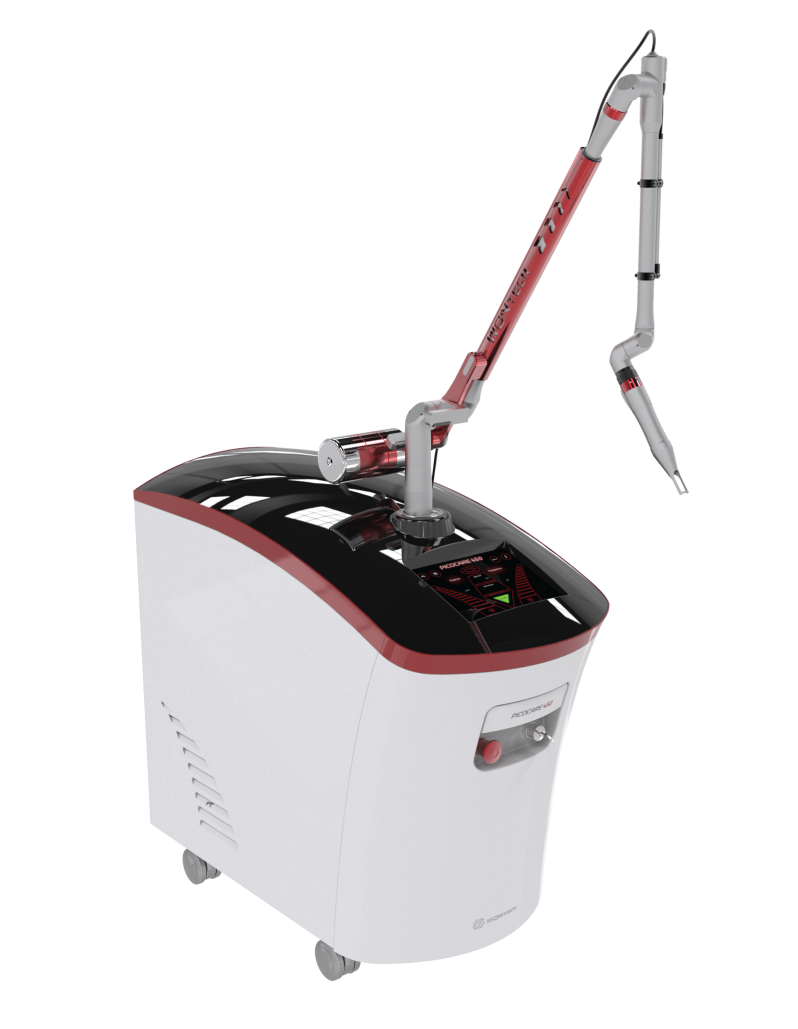Benefits of Picocare
The fractional tip of Picocare is an MLA modehandpiece without little to no energy drop. It allows consistent energy level throughout irradiation. When not considering the fractional tip, Picocare has a lower risk of side effects compared to nanosecond lasers. In treating melasma, melanocyte damage is a key issue. The picosecond laser has close affinity to the SRT of melanin which prevents the shock waves from escaping the target tissue. This causes less damage to melanocytes and less pain during treatment. Clear improvement can be seen quickly and what I find particularly satisfying is that the risk of side effects is very low with dermal lesions. I am aware that there is controversy over its efficacy in Ota’s nevus and ABNOM. Personally, the 1064nm or755nmlong pulsed laser or IPL may be more suitable in such cases. Therefore, I use Picocare in dermal lesions such as melasma and the long-pulsed laser in other types of pigmented lesions.
Picocare has the advantage of emitting multiple wavelengths, however, I prefer the 1064nm in most cases. The Asian skin is susceptible to PIH at532nm and the picosecond laser can still cause side effects althougth the risk is lower than with the nanosecond laser. I use particular caution with the fractional tip.
Indications outside pigmented lesions
Currently, I use Picocare in scar, pore and pigment treatments. The traditional fractional laser was effective but patients were often averse to the pain and downtime. I would say the level of pain with Picocare is only at about 30% of that with the traditional fractional laser. The downtime is also much shorter and patients feel more comfortable during and after the treatment.
The picosecond laser is particularly beneficial in scar treatment because it promotes collagenesis and skin tightening, which in turn improves pores as well. To isolate the effect of the MLA fractional tip, I do not combine Picocare with other modalities in scar treatment. However, in melasma I prefer the combination therapy.
Advice on minimizing side effects
With a shorter pulse duration, adjusting by only0.1J changes the output density much more drastically than with the nanosecond laser. Caution is needed as the energy level might be raised too much by mistake. The fractional tip lowers the output and increases safety. This necessitates a higher number of treatments but I think this is a small price to pay to avoid side effects
Why do you recommend Picocare?
The handpiece is not all-in-one and the tip needs to be replaced. This is a minor inconvenience but I expect it will be improved soon. It has been almost four years since the picosecond laser entered the market but the price of a single device still exceeds KRW 100 million (approx.. USD 90,000).For picosecond laser treatments, I charge 30% higher than other treatments but a device at this price range is not an easy purchase for most private practices. Considering that the Nd:YAGlaser continuously performs well over a decade, the piicosecondlaser may be a good investment in the long run. The trends are moving towards picosecond and even femtosecond and the picosecond laser will eventually become a standard. If it is something that you have to purchase eventually, it would be better to have it earlier so that you can get an advantage over others.

Dr. Min-ho Lee of Bestop Clinic decided to purchase Picocare because he trustsWontech’s technology shown inthe excellent performance of Pastelle.
HELIOSⅡ/LOTUSⅡ/HYPERION – Manufacturer: LASEROPTEK(www.laseroptek.com)
-To be continued-




















